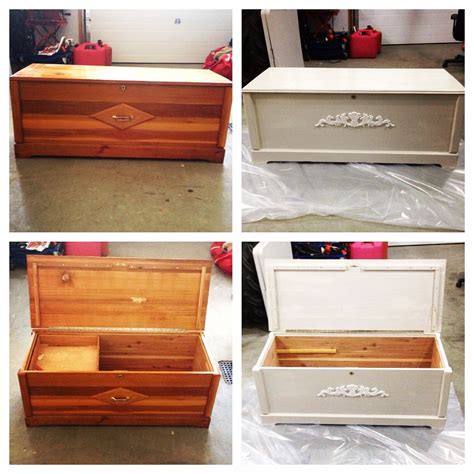How To Restore A Cedar Chest
Ronan Farrow
Apr 02, 2025 · 4 min read

Table of Contents
How to Restore a Cedar Chest: A Step-by-Step Guide
Cedar chests are beautiful, practical pieces of furniture that can last for generations. However, time and use can take their toll, leaving your cherished chest looking dull and worn. This comprehensive guide will walk you through the process of restoring your cedar chest to its former glory, bringing back its natural beauty and extending its lifespan.
Assessing Your Cedar Chest: The First Step to Restoration
Before you begin, it's crucial to assess the condition of your cedar chest. This involves identifying the type of damage, which will dictate the necessary restoration steps. Look for:
- Surface damage: Scratches, dents, water stains, or minor discoloration.
- Structural damage: Loose joints, broken pieces, or significant warping.
- Hardware issues: Rusty hinges, broken latches, or tarnished handles.
- Finish issues: Chipped, peeling, or faded varnish or paint.
Knowing the extent of the damage will help you plan your restoration project effectively and gather the necessary tools and materials.
Tools and Materials You'll Need
Gather these essential tools and materials before starting your restoration:
- Cleaning supplies: Mild soap, warm water, soft cloths, fine steel wool (optional), and a vacuum cleaner with a brush attachment.
- Wood repair products: Wood filler, sandpaper (various grits), and wood glue (for structural repairs).
- Finishing supplies: Cedar oil (for conditioning and scent), varnish or polyurethane (for protection), paint (if necessary), and paintbrushes or rags.
- Hardware supplies: Replacement hinges, latches, or handles (if needed).
- Protective gear: Gloves, eye protection, and a dust mask.
Step-by-Step Restoration Process
Now, let's dive into the restoration process itself:
1. Cleaning Your Cedar Chest
Begin by thoroughly cleaning your cedar chest. Use a vacuum with a brush attachment to remove dust and debris from all surfaces, crevices, and corners. Then, gently wipe down the entire chest with a soft cloth dampened with mild soapy water. Avoid excessive moisture. Allow the chest to dry completely before proceeding. For stubborn stains, carefully use fine steel wool, but always test on an inconspicuous area first.
2. Repairing Structural Damage
Address any structural damage before tackling surface imperfections. If you have loose joints, apply wood glue and clamp them firmly until dry. For broken pieces, carefully use wood filler to repair any cracks or gaps, ensuring a smooth finish after it dries and sanding it down.
3. Repairing Surface Damage
Once structural repairs are complete, focus on surface imperfections. Use wood filler to repair dents and scratches, sanding it smooth once dry. For deeper gouges or chips, you may need to apply multiple layers of filler and sand thoroughly between each layer to achieve an even surface.
4. Restoring the Finish
The type of finish on your cedar chest will influence this step. If the finish is significantly damaged or peeling, you may need to strip it completely before reapplying a new finish. However, if the finish is just dull or scratched, you can try cleaning and polishing it with a suitable wood cleaner or applying a thin coat of varnish or polyurethane for protection and to restore luster. For a natural look, consider using cedar oil to condition and enhance the natural scent of the wood.
5. Replacing Hardware
If necessary, replace any damaged or tarnished hardware. This might involve replacing hinges, latches, or handles. Ensure the new hardware matches the style and finish of your cedar chest.
6. Final Touches
Once you've completed all the repairs and refinishing, allow the chest to dry completely before using it. You can apply a final coat of wax for extra protection and shine.
Maintaining Your Restored Cedar Chest
To keep your restored cedar chest looking its best for years to come, remember to:
- Regular Cleaning: Dust regularly with a soft cloth.
- Avoid Direct Sunlight: Prolonged exposure to sunlight can damage the finish.
- Use Cedar Oil: Periodically apply cedar oil to maintain the wood's natural beauty and scent.
- Protect from Moisture: Keep the chest in a dry environment to prevent warping or damage.
By following these steps, you can successfully restore your cedar chest, bringing back its charm and extending its life. Remember, patience and attention to detail are key to achieving the best results. Now, enjoy your beautifully restored piece of furniture!
Featured Posts
Also read the following articles
| Article Title | Date |
|---|---|
| How To Sew Ripstop Nylon | Apr 02, 2025 |
| How To Remove Drive Shaft From Transfer Case | Apr 02, 2025 |
| How To Tell Fake Prada Sunglasses | Apr 02, 2025 |
| How To Remove Spray Paint From Gun | Apr 02, 2025 |
| How To Sell Homeowners Insurance | Apr 02, 2025 |
Latest Posts
-
Judgement How Someone Feels About You
Apr 03, 2025
-
Jack Howe Memorial Tournament
Apr 03, 2025
-
Invisalign Refinements How Many
Apr 03, 2025
-
Invisalign How Many Refinements
Apr 03, 2025
-
If I M Shooting High How Do I Adjust My Scope
Apr 03, 2025
Thank you for visiting our website which covers about How To Restore A Cedar Chest . We hope the information provided has been useful to you. Feel free to contact us if you have any questions or need further assistance. See you next time and don't miss to bookmark.
